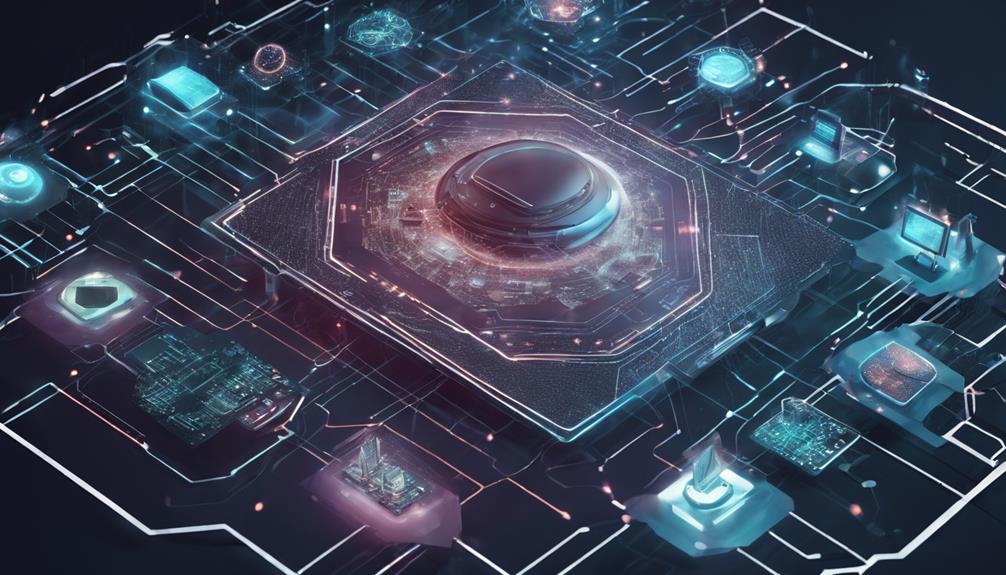Guarantee your data protection with advanced AI cybersecurity solutions. Instant threat detection and proactive mitigation safeguard against intrusions. Automation boosts efficiency by speeding up log analysis and minimizing manual tasks. Behavioral analysis pinpoints anomalies for swift fraud prevention. Penetration testing identifies vulnerabilities with simulated attacks, bolstering security posture. Cost-effective measures optimize resource allocation and reduce operational expenses. Embrace diverse datasets and ethical frameworks for unbiased security. Guarantee regulatory alignment with standards like the EU's AI Act. Discover a thorough shield for your data integrity and security.
Key Takeaways
- AI cybersecurity solutions offer real-time threat detection and mitigation for comprehensive data protection.
- Automation through AI streamlines tasks for efficient threat detection and response.
- Behavioral analysis techniques identify anomalies, enhancing fraud prevention and threat monitoring.
- Penetration testing solutions powered by AI evaluate vulnerabilities for enhanced security resilience.
- Cost-effective measures reduce operational expenses while providing extensive data protection.
Threat Detection and Mitigation
With the advancement of AI cybersecurity solutions, organizations can now effectively detect and mitigate threats in real-time, enhancing their overall security posture.
AI systems are revolutionizing threat detection by analyzing patterns and behaviors instantly, enabling proactive threat detection and mitigation strategies.
By harnessing AI capabilities for threat analysis, organizations can swiftly identify and respond to potential threats, preventing incidents and reducing damage to sensitive data and systems.
AI-driven cybersecurity solutions focus on enhancing intrusion detection and prevention, safeguarding organizations from cyber attacks.
These all-encompassing security measures offer a holistic approach to minimizing loss through rapid threat detection and real-time response mechanisms.
By integrating AI into their cybersecurity frameworks, organizations can strengthen their defenses and stay ahead of evolving threats in the digital landscape.
Leveraging AI for threat mitigation not only enhances security measures but also instills confidence in stakeholders regarding data protection and overall cybersecurity readiness.
Automation for Efficiency
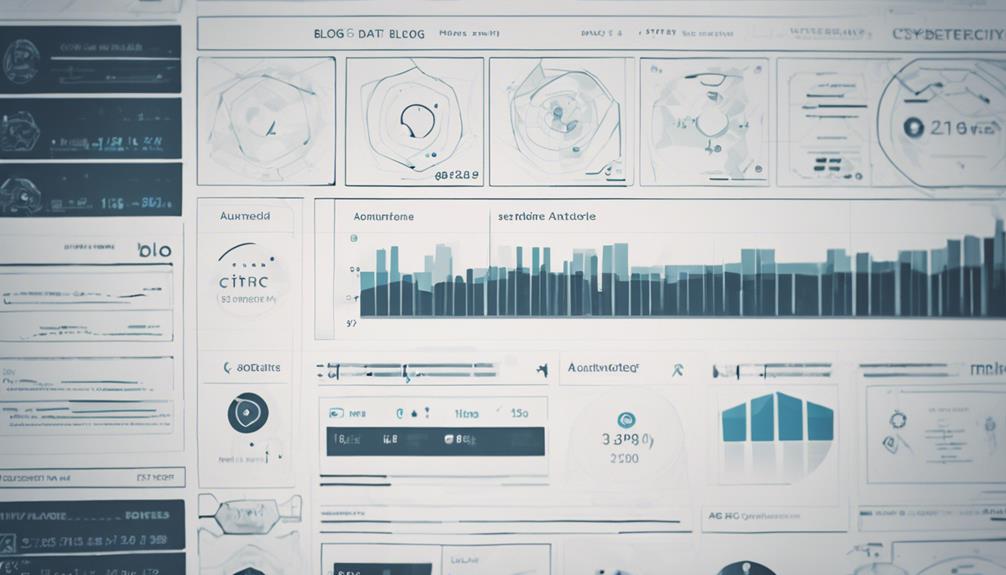
Automation in cybersecurity operations is a game-changer for organizations looking to boost efficiency. By leveraging AI-enabled automation, tasks like log analysis, vulnerability assessments, and incident responses can be streamlined to enhance overall cybersecurity capabilities.
Not only does AI automation speed up threat detection, but it also minimizes manual efforts and resource consumption, making cybersecurity operations more effective and agile.
Streamlined Threat Detection
AI cybersecurity solutions optimize threat detection processes through streamlined automation for enhanced efficiency. By leveraging AI technology in cybersecurity, organizations can effectively detect and respond to potential threats in real-time, ensuring the protection of sensitive data and systems.
The following are key benefits of streamlined threat detection using AI:
- Automated log analysis and monitoring enhance the ability to detect anomalies quickly.
- Vulnerability assessments are conducted promptly and continuously to identify weak points in the system.
- Incident responses are triggered automatically, minimizing response time and reducing the impact of security breaches.
- Consolidated reports generated by AI solutions provide extensive insights for informed decision-making.
- Continuous monitoring and real-time analysis enable proactive measures to mitigate potential security risks before they escalate.
Through the integration of AI-driven automation in threat detection processes, organizations can strengthen their cybersecurity posture, minimize manual intervention, and improve overall operational efficiency.
Enhanced Response Capabilities
Enhancing response capabilities through automated processes in cybersecurity operations optimizes efficiency and strengthens overall threat management strategies. AI-enabled solutions play an important role in automating responses, reducing incident response times, and enhancing threat detection.
By leveraging AI in cybersecurity operations, organizations can greatly improve their efficiency by minimizing manual interventions and streamlining processes.
Automated responses facilitated by AI not only accelerate incident handling but also help in consolidating reports from diverse sources, thereby reducing operational costs. The faster detection of threats through automation enables quicker responses, ultimately enhancing the overall cybersecurity posture of an organization.
Through efficient data analysis and automated incident response, AI-driven solutions empower cybersecurity teams to respond promptly and effectively to potential threats. This enhanced capability not only boosts response times but also ensures a more robust defense mechanism against evolving cyber threats.
Behavioral Analysis Techniques
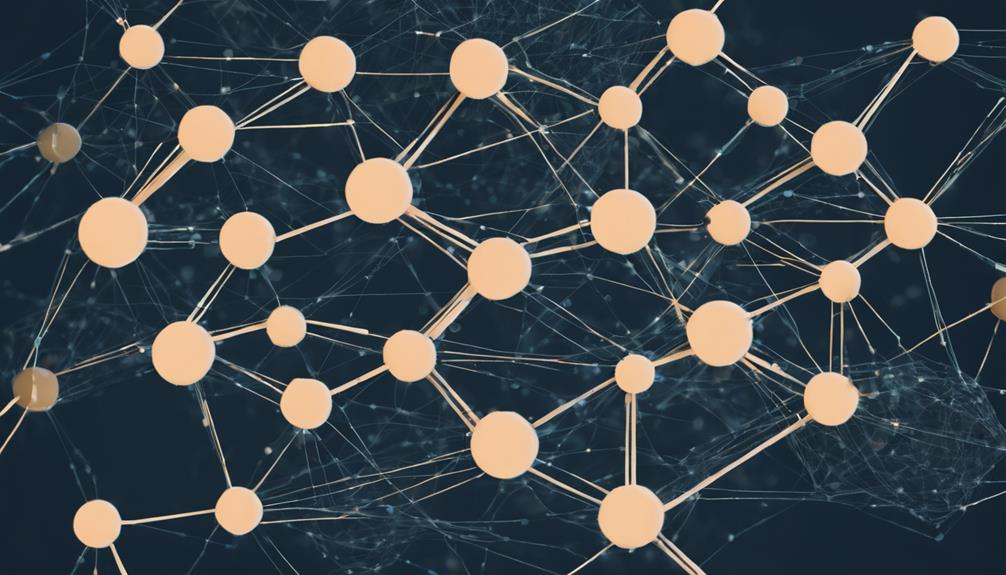
Utilizing sophisticated algorithms and machine learning, behavioral analysis techniques in cybersecurity employ user actions and patterns to proactively identify anomalies and potential security threats. By analyzing user behavior, these techniques can detect deviations from normal patterns and flag suspicious activities that may indicate fraud or other malicious intent.
Here are five key points highlighting the importance of behavioral analysis techniques in cybersecurity:
- AI models user behavior to identify anomalies and potential threats.
- The techniques help in fraud prevention by monitoring and analyzing user actions.
- By understanding normal patterns, AI can quickly recognize abnormal activities.
- Behavioral analysis plays a vital role in threat detection and response.
- These techniques enhance the speed and accuracy of identifying security threats.
Incorporating behavioral analysis into cybersecurity strategies can significantly strengthen defenses against evolving cyber threats and safeguard sensitive data more effectively.
Penetration Testing Solutions

Penetration testing solutions powered by AI technology are instrumental in evaluating network vulnerabilities and pinpointing security weaknesses.
By simulating real-world cyber attacks, these tools proactively identify potential entry points for malicious actors and outdated system components.
Implementing AI-driven penetration testing can greatly enhance an organization's security posture and fortify defenses against evolving cyber threats.
Test Network Vulnerabilities
Identifying network vulnerabilities through simulated cyber attacks is an essential component of an organization's cybersecurity strategy. Penetration testing solutions play a pivotal role in enhancing network security by uncovering weaknesses that could be exploited by malicious actors.
By conducting controlled attacks, these solutions provide valuable insights into an organization's security posture, enabling them to strengthen their cybersecurity defense mechanisms. Regular testing with penetration testing solutions is imperative for maintaining a robust security resilience and staying ahead of potential threats.
Here are some key points to keep in mind when testing network vulnerabilities:
- Penetration testing solutions leverage AI technology to mimic real-world cyber threats.
- These tests help organizations understand their vulnerabilities and prioritize remediation efforts.
- By identifying weaknesses proactively, organizations can enhance their overall security posture.
- Penetration testing solutions offer actionable recommendations to improve cybersecurity defenses.
- Testing network vulnerabilities regularly is essential for enhancing cybersecurity resilience.
Identify Security Weaknesses
AI-powered cybersecurity solutions offer a thorough approach to detecting security vulnerabilities within networks and systems through simulated cyber attacks. Penetration testing solutions play an essential role in identifying potential threats and weaknesses in an organization's security infrastructure.
By leveraging advanced AI models, these solutions conduct detailed vulnerability assessments to pinpoint security weaknesses that could be exploited by malicious actors. Automated penetration testing tools enhance the efficiency and accuracy of these assessments, enabling organizations to proactively address security gaps before they are compromised.
Regularly employing AI-driven penetration testing solutions is crucial in fortifying security measures against evolving threats in today's digital landscape. These tools not only provide insights into existing vulnerabilities but also aid in strengthening overall cybersecurity defenses.
Vulnerability Identification Methods
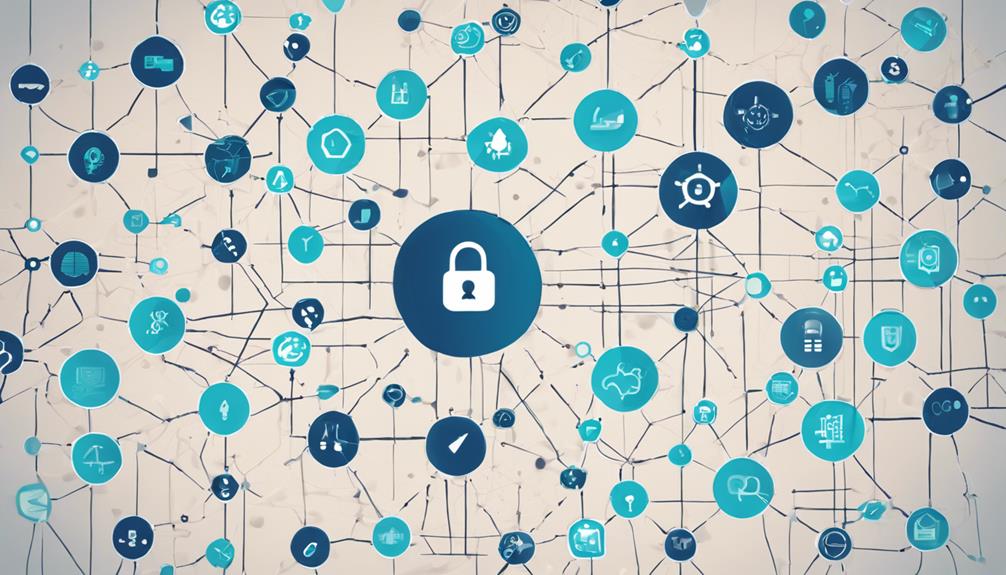
Advanced AI cybersecurity solutions employ sophisticated methods to pinpoint vulnerabilities within networks and systems. These cutting-edge vulnerability identification methods play an essential role in enhancing the overall security posture of organizations.
Here are five key techniques utilized by AI-driven systems:
- AI-driven penetration testing: Proactively identifies risks by simulating cyber attacks and uncovering potential vulnerabilities.
- Threat detection accuracy: By analyzing patterns and behaviors, AI algorithms enhance the precision of identifying potential threats, reducing the risk of successful cyber attacks.
- Enhanced security measures: AI algorithms simulate social engineering attacks to strengthen security protocols and mitigate vulnerabilities.
- Reduced manual intervention: AI-powered vulnerability identification reduces the need for manual intervention, streamlining analysis processes.
- Decreased false positives: By leveraging AI technology, cybersecurity operations experience a decrease in false positives, allowing for more precise identification of genuine threats.
These methods not only improve the efficiency of cybersecurity operations but also provide a proactive approach to safeguarding sensitive data against evolving cyber threats.
Cost-Effective Security Measures

Effective cost management in cybersecurity operations is essential for organizations aiming to optimize their security measures while minimizing expenses. AI cybersecurity solutions offer a thorough approach by automating manual tasks, which not only reduces costs but also saves time and resources.
By leveraging AI-driven security measures, organizations can minimize the need for manual monitoring, leading to a reduction in operational expenses. The efficiency brought about by AI automation in cybersecurity operations helps streamline processes and enhance overall cost-effectiveness.
Implementing AI can also help organizations avoid wasteful resource allocation towards investigating false positives, further optimizing cost-effectiveness. Cost-effective security measures powered by AI provide extensive protection for data while simultaneously reducing overall cybersecurity expenses.
Embracing AI in cybersecurity not only fortifies data protection but also contributes to significant savings, making it a strategic investment for organizations looking to enhance their security posture in a cost-efficient manner.
Bias and Ethical Considerations

Organizations deploying AI cybersecurity solutions must prioritize addressing bias and ethical considerations to guarantee fair and transparent decision-making processes in their security operations.
To secure ethical AI practices and mitigate risks associated with biased algorithms, organizations should consider the following:
- Utilize diverse datasets: Incorporating a broad range of data sources can help reduce bias by providing a more extensive view of potential threats.
- Conduct regular audits: Periodic reviews of AI algorithms can identify and address any biases that may have emerged over time.
- Implement ethical frameworks: Adhering to established ethical guidelines can guide decision-making processes and promote fairness in security operations.
- Build trust: Transparency and accountability in AI cybersecurity practices are essential for fostering trust with users and stakeholders.
- Monitor and adjust: Continuously monitoring AI systems and being willing to make adjustments can help maintain ethical standards and prevent bias from influencing outcomes.
Compliance and Regulatory Alignment
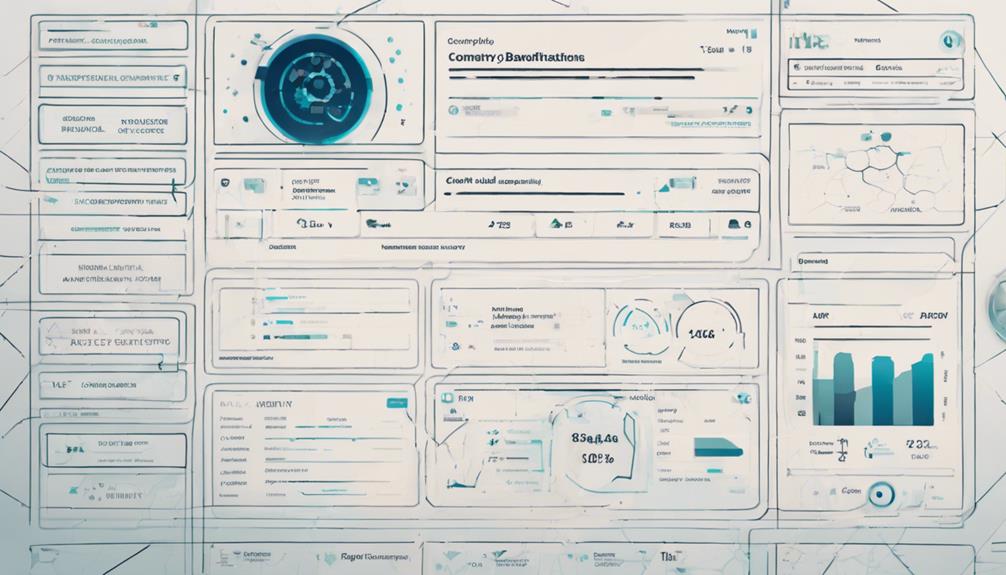
Ensuring compliance with key regulations and aligning with industry guidelines is a crucial aspect of implementing AI cybersecurity solutions within organizations. Regulations such as the EU's AI Act and standards from OWASP and NIST play an essential role in safeguarding data protection.
AI security solutions are instrumental in helping organizations meet regulatory requirements by addressing specialized threats and compliance needs effectively. Companies are increasingly turning to governance and compliance tools to manage AI-related risks, ensuring adherence to regulatory standards and enhancing data security measures.
Wavestone's AI Security Solutions Radar provides valuable insights into cutting-edge cybersecurity solutions tailored to guarantee regulatory alignment. As the AI security market evolves to meet the rising demand for solutions that align with regulations, organizations are better positioned to fortify their data protection strategies.
Frequently Asked Questions
How Do I Protect My Personal Data From Ai?
To protect personal data from AI, implement strong encryption, update privacy settings, be cautious with permissions, use reputable cybersecurity tools with AI, and stay informed about AI privacy risks. Proactive measures are essential for data protection.
How Can AI Be Used for Cyber Security?
AI in cybersecurity is utilized for threat detection, incident response, and continuous monitoring. It enhances security by accelerating threat analysis, identifying advanced threats, and reducing false positives. AI integration involves algorithm updates, system integration, and professional training.
What Is an Example of AI in Data Security?
An example of AI in data security includes the utilization of machine learning algorithms to detect anomalies and patterns in user behavior, enabling real-time threat identification and response. AI enhances encryption, access control, and threat detection for thorough protection.
Can AI Be a Threat to Data Privacy?
In the domain of data security, the intricate dance between AI's potential and data privacy concerns is undeniable. While AI offers unparalleled protection, its very essence can inadvertently pose threats to data privacy, demanding careful oversight.
Conclusion
To sum up, the deployment of an AI cybersecurity solution provides thorough protection for your data by leveraging advanced threat detection and mitigation techniques. It incorporates automation for efficiency, behavioral analysis methods, penetration testing solutions, and vulnerability identification measures. Moreover, it offers cost-effective security measures and ensures alignment with compliance and regulatory standards.
By investing in these innovative technologies, you can safeguard your valuable information and guarantee the integrity of your digital assets.
